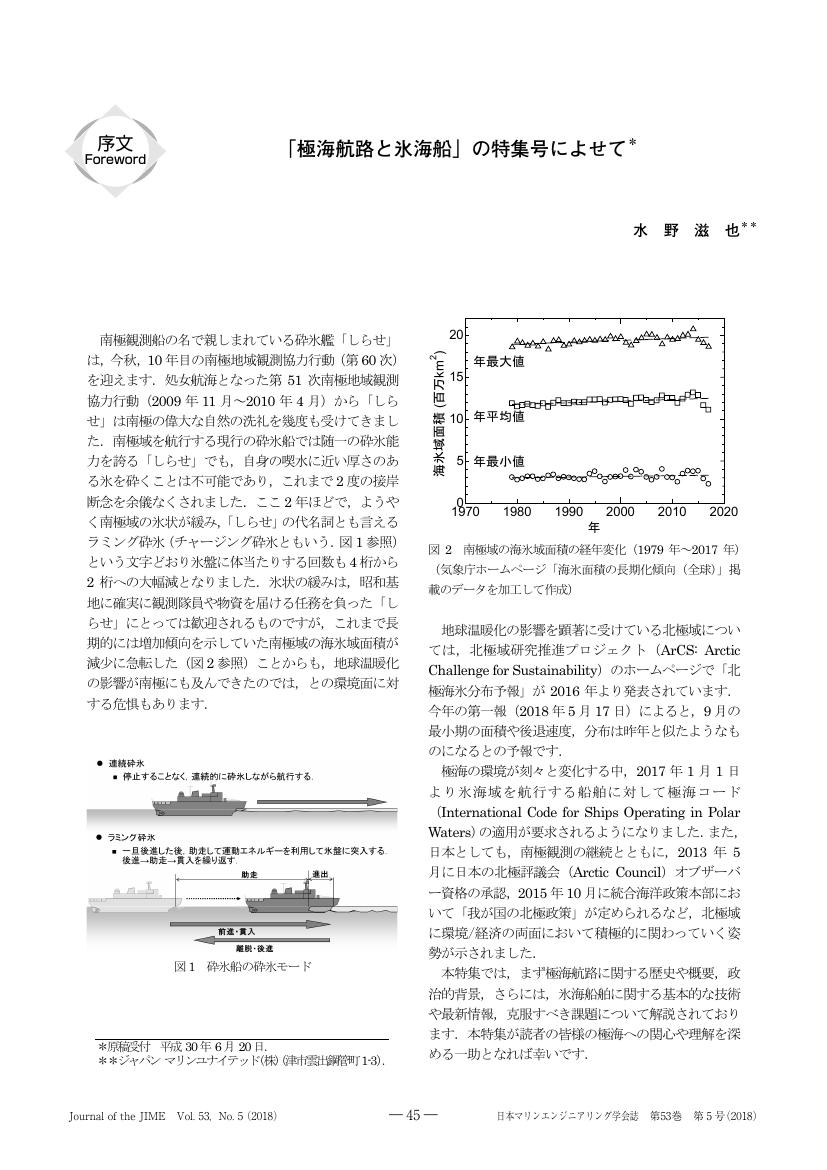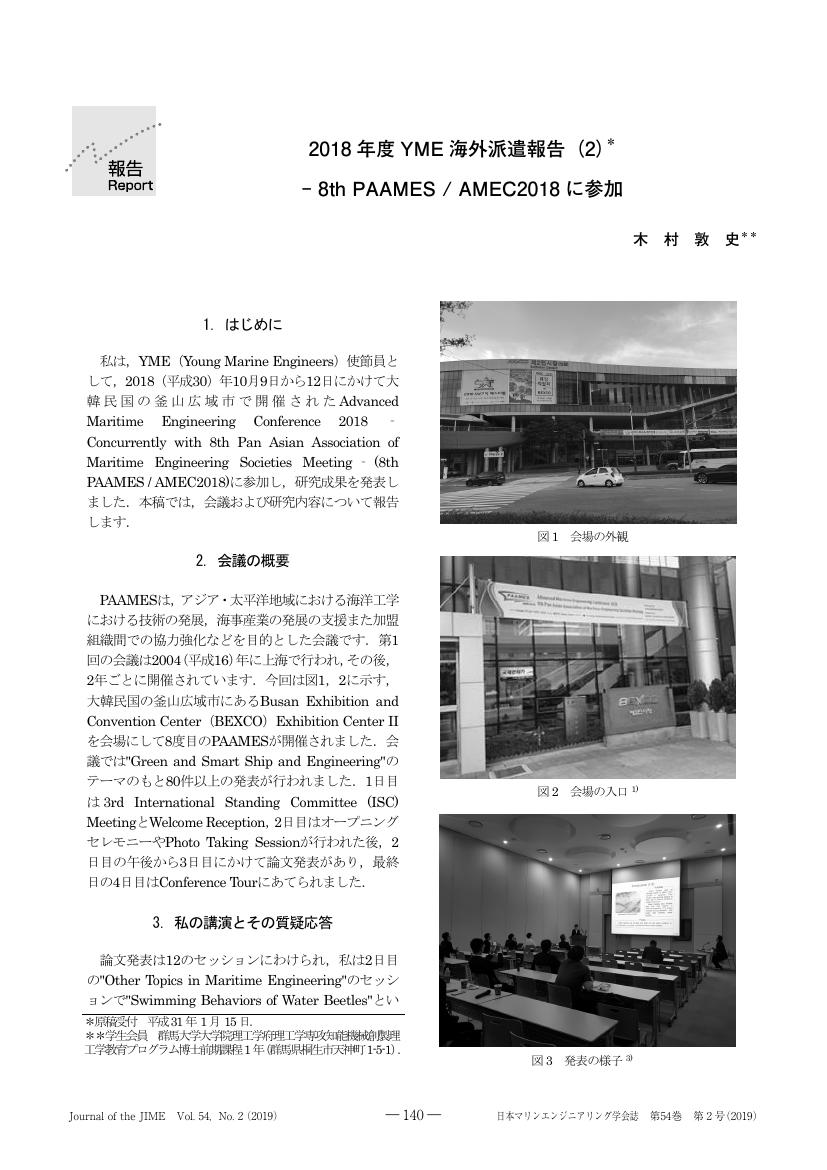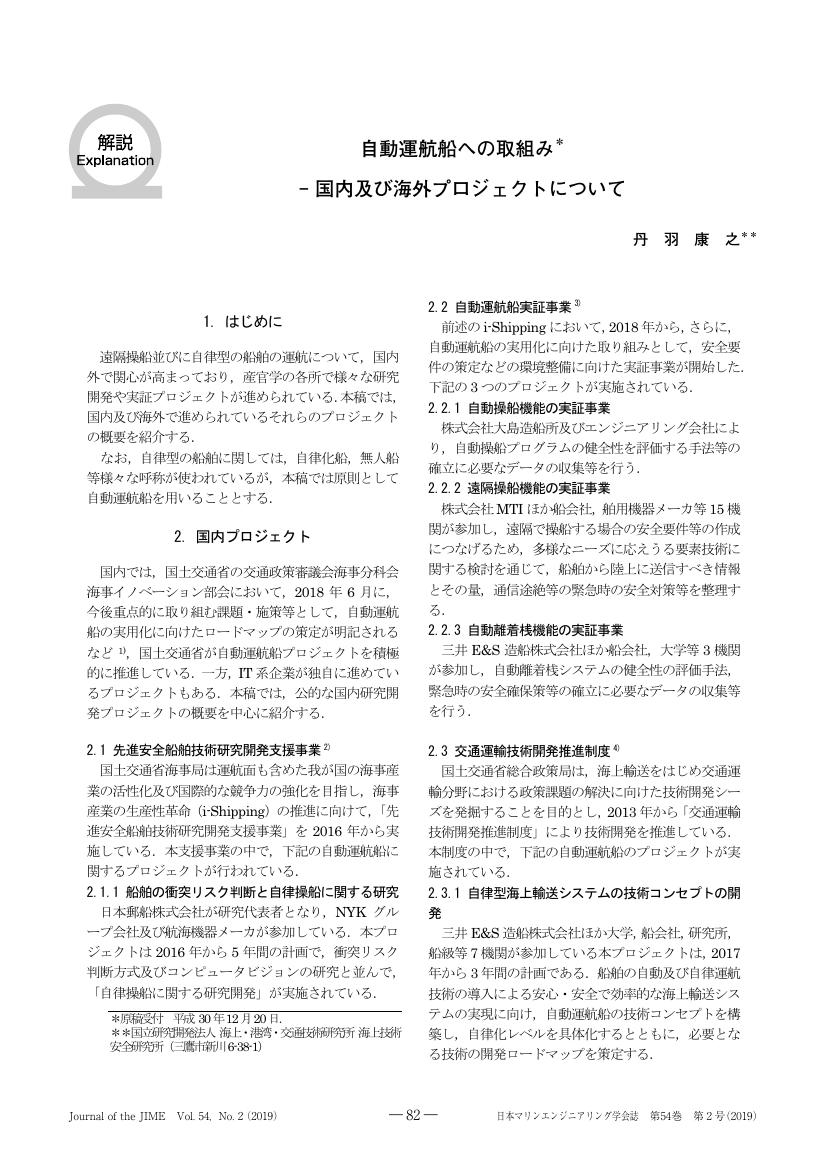1 0 0 0 OA TBTポリマーに替わる新しい防汚塗料用樹脂
- 著者
- 山盛 直樹
- 出版者
- 公益社団法人 日本マリンエンジニアリング学会
- 雑誌
- マリンエンジニアリング (ISSN:13461427)
- 巻号頁・発行日
- vol.40, no.1, pp.20-22, 2005-01-01 (Released:2010-05-31)
- 参考文献数
- 3
- 著者
- 井手 雅夫
- 出版者
- 公益社団法人 日本マリンエンジニアリング学会
- 雑誌
- マリンエンジニアリング (ISSN:13461427)
- 巻号頁・発行日
- vol.52, no.5, pp.610-617, 2017
1 0 0 0 「舶用電気設備の技術動向」特集号によせて
- 著者
- 雨宮 徳一
- 出版者
- 公益社団法人 日本マリンエンジニアリング学会
- 雑誌
- マリンエンジニアリング (ISSN:13461427)
- 巻号頁・発行日
- vol.48, no.5, pp.587, 2013
- 著者
- 長屋 茂樹
- 出版者
- 公益社団法人 日本マリンエンジニアリング学会
- 雑誌
- マリンエンジニアリング (ISSN:13461427)
- 巻号頁・発行日
- vol.54, no.2, pp.283-286, 2019-03-01 (Released:2019-03-29)
- 参考文献数
- 2
1 0 0 0 OA 微粒子ピーニングによる表面改質手法 - 生産性を考慮した複合表面改質技術の提案
- 著者
- 宇佐美 初彦
- 出版者
- 公益社団法人 日本マリンエンジニアリング学会
- 雑誌
- マリンエンジニアリング (ISSN:13461427)
- 巻号頁・発行日
- vol.55, no.1, pp.28-33, 2020-01-01 (Released:2020-01-29)
- 参考文献数
- 21
1 0 0 0 OA 海洋掘削のためのライザー管について
- 著者
- 小川 和彦
- 出版者
- 公益社団法人 日本マリンエンジニアリング学会
- 雑誌
- マリンエンジニアリング (ISSN:13461427)
- 巻号頁・発行日
- vol.50, no.5, pp.688, 2015-09-01 (Released:2016-12-03)
- 参考文献数
- 2
- 著者
- Dhimas W. Handani I Made Ariana Taufik F. Nugroho Fadilla Indrayuni
- 出版者
- The Japan Institute of Marine Engineering
- 雑誌
- マリンエンジニアリング (ISSN:13461427)
- 巻号頁・発行日
- vol.53, no.3, pp.386-391, 2018-05-01 (Released:2018-05-19)
- 参考文献数
- 9
- 被引用文献数
- 1 3
Ship exhaust gas emission becomes one of the main sources of marine environment pollution. This imposes significantly on the health risk along the area which has densely traffic of ship. The aim of this paper is to conduct an estimation of emission distribution of ships in the Madura Strait which is one of the busiest access channels in Indonesia. Vessel activity based approach is utilized for estimating the emission of ships by inputting the power of main engine (ME), auxiliary engine (AE) and auxiliary boiler(AB), engine load factor, time in mode and emission factor. Operation mode of ships are categorized as maneuvering, fairway cruising, low cruising and hoteling. Automatic Identification System (AIS) is used to identify all data of ships which are operated in the Madura Strait both the static and dynamics data. The static data includes MMSI (Maritime Mobile Service Identity), IMO number, type of ship, call sign and ship dimension, while dynamics data such as ship speed, position and navigation status. Ship information from AIS is used as input for ship database for knowing the engine power, actual and design speed which are needed to estimate the ship emission, including carbon monoxide (CO), Nitrogen oxides (NOX), sulfur oxides (SOX) and particulate matter (PM). In this study, ships operation data obtained from AIS and the emission estimation are combined to do a simulation using Hybrid Single Particle Lagrangian Integrated Trajectory (HYSPLIT) Model to generate emission map which shows the inventory of emission distribution. Result shows that the emission of SO2 and NOX are much higher than the other pollutant. The total emission of AE is higher than that of ME because most of ships are in the mode of hoteling. The dispersion model reveals that the pollutant reaches location of resident around the Madura Strait. Output of this study can be used as consideration for the government to regulate an effective policy regarding the ships emission to control the marine pollution at sea for better environmental health.
1 0 0 0 OA ME-GI機関を搭載したLNG船の紹介
- 著者
- 渡邉 貴士 柴田 繁志
- 出版者
- 公益社団法人 日本マリンエンジニアリング学会
- 雑誌
- マリンエンジニアリング (ISSN:13461427)
- 巻号頁・発行日
- vol.49, no.1, pp.13-19, 2014-01-01 (Released:2015-07-07)
- 参考文献数
- 6
1 0 0 0 OA 初代南極観測船“宗谷”の歩み - 奇跡の船のものがたり
- 著者
- 飯沼 一雄
- 出版者
- 公益社団法人 日本マリンエンジニアリング学会
- 雑誌
- マリンエンジニアリング (ISSN:13461427)
- 巻号頁・発行日
- vol.55, no.1, pp.109-113, 2020-01-01 (Released:2020-01-29)
1 0 0 0 OA AUVのドッキング及び水中充電技術の開発について
- 著者
- 柴田 陽三 藤永 隆志
- 出版者
- The Japan Institute of Marine Engineering
- 雑誌
- マリンエンジニアリング (ISSN:13461427)
- 巻号頁・発行日
- vol.37, no.9, pp.647-653, 2002-09-01 (Released:2010-05-31)
- 参考文献数
- 9
The lack of power source capacity is one of the most fatal problems for the AUV spotlighted as a means of underwater survey and observation of the next generation, to be attacked for its practical use. To be free from such a problem, some long-term-cruising-AUVs employ with a large capacity power source like a closed cycle diesel engine or a fuel cell. On the other hand, if underwater recharging system for conventional batteries is developed, that will help us make the AUVs more practical without increasing its size, weight and cost. And such a new method of the AUV can be expected that the AUV is operated in combination with underwater bases or large submersibles.Now, we have carried out to develop such an AUV, called“MARINEBIRD”, that is capable of docking in an underwater station and recharging the battery. This kind of technologies have already been underwatertested in the U.S.A. and European countries, but our newly developed AUV is based on our original mechanism for docking, different from such ones.The MARINEBIRD succeeded the docking test in the dock trial, and demonstrated the excellence of its autonomous docking capability.The MARINEBIRD has the big advantage of charging batteries and receiving data at the underwater base without recovery by the surface support ship or such purposes as required in combination with a larger submersible, that will contribute to increase efficiency in underwater survey.
1 0 0 0 OA 「極海航路と氷海船」の特集号によせて
- 著者
- 水野 滋也
- 出版者
- 公益社団法人 日本マリンエンジニアリング学会
- 雑誌
- マリンエンジニアリング (ISSN:13461427)
- 巻号頁・発行日
- vol.53, no.5, pp.663, 2018-09-01 (Released:2018-11-09)
1 0 0 0 OA 燃料噴射弁の開弁圧力低下による燃焼の変化とその原因解明
- 著者
- 山谷 尚弘 見上 博 張 勁 平澤 良男 石原 外美 手﨑 衆
- 出版者
- 公益社団法人 日本マリンエンジニアリング学会
- 雑誌
- マリンエンジニアリング (ISSN:13461427)
- 巻号頁・発行日
- vol.53, no.1, pp.140-146, 2018-01-01 (Released:2018-03-14)
- 参考文献数
- 10
Fuel injection pressure decreases in four-stroke diesel engines after extended operations. Poor combustion caused by the pressure drop is a serious problem that can lead to environmental pollution. Several factors have been considered to be behind mechanisms to decrease fuel injection pressure, but the details of such mechanisms are still unknown. Up until now, only limited numbers of studies have been conducted to define these mechanisms. In this study, we clarified that stress relaxation, buckling and metal fatigue of the pressure regulating spring in the fuel injection valve contribute to lowering injection pressure. We also found that the lowering of injection pressure causes early and prolonged injection in diesel engines.
- 著者
- 木村 敦史
- 出版者
- 公益社団法人 日本マリンエンジニアリング学会
- 雑誌
- マリンエンジニアリング (ISSN:13461427)
- 巻号頁・発行日
- vol.54, no.2, pp.262-264, 2019-03-01 (Released:2019-03-29)
- 参考文献数
- 5
1 0 0 0 OA シリンダ注油システムの最新動向
- 著者
- 阪口 勝彦 山本 哲也
- 出版者
- 公益社団法人 日本マリンエンジニアリング学会
- 雑誌
- マリンエンジニアリング (ISSN:13461427)
- 巻号頁・発行日
- vol.40, no.2, pp.222-228, 2005-03-01 (Released:2010-05-31)
- 参考文献数
- 4
1 0 0 0 OA 二重反転プロペラシステム用シール装置 - 各種システムの紹介とシール装置の最適化
- 著者
- 齋藤 健一
- 出版者
- 公益社団法人 日本マリンエンジニアリング学会
- 雑誌
- マリンエンジニアリング (ISSN:13461427)
- 巻号頁・発行日
- vol.52, no.2, pp.166-169, 2017-03-01 (Released:2018-03-01)
- 参考文献数
- 1
1 0 0 0 OA 自動運航船への取組み - 国内及び海外プロジェクトについて
- 著者
- 丹羽 康之
- 出版者
- 公益社団法人 日本マリンエンジニアリング学会
- 雑誌
- マリンエンジニアリング (ISSN:13461427)
- 巻号頁・発行日
- vol.54, no.2, pp.204-209, 2019-03-01 (Released:2019-03-29)
- 参考文献数
- 30
- 被引用文献数
- 2
1 0 0 0 OA 2017年におけるマリンエンジニアリング技術の進歩
1 0 0 0 海洋での掘削技術
- 著者
- 吉田 肇
- 出版者
- 公益社団法人 日本マリンエンジニアリング学会
- 雑誌
- マリンエンジニアリング (ISSN:13461427)
- 巻号頁・発行日
- vol.50, no.5, pp.626-632, 2015
1 0 0 0 OA 海洋での掘削技術
- 著者
- 吉田 肇
- 出版者
- 公益社団法人 日本マリンエンジニアリング学会
- 雑誌
- マリンエンジニアリング (ISSN:13461427)
- 巻号頁・発行日
- vol.50, no.5, pp.626-632, 2015-09-01 (Released:2016-12-03)
- 参考文献数
- 11
1 0 0 0 OA 船舶における『音力発電』および『振動力発電』の応用提案
- 著者
- 速水 浩平
- 出版者
- 公益社団法人 日本マリンエンジニアリング学会
- 雑誌
- マリンエンジニアリング (ISSN:13461427)
- 巻号頁・発行日
- vol.44, no.2, pp.185-188, 2009 (Released:2012-04-20)













